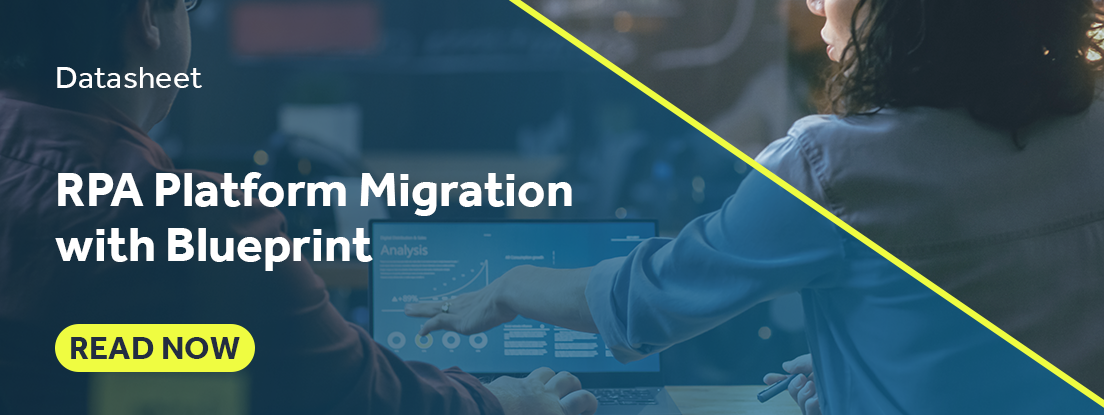9 Use Cases of RPA in Finance and Accounting
Here’s the thing, robots don’t need a coffee break, they don’t get tired, and they don’t lose focus after spending countless hours working on payroll, billing, or inputting information into Excel spreadsheets.
But humans do.Over the last decade, finance and accounting professionals have become overwhelmed by the increase in transactional volume, repetitive work, and large volumes of data that need to be managed within a largely understaffed team. Turning to robotic process automation (RPA) seems like a natural next step for the finance and accounting sector as they look to automate labor-intensive, repetitive processes.
Learn More: Best Practices for Achieving RPA at Scale
But, as we already know - not all RPA projects go off without a hitch. In fact, nearly 40% of RPA projects fail to meet their objectives and are unable to scale—it's why so many RPA programs are looking to switch RPA vendors to realize the returns and scale they were promised.
Learn More: Why organizations are looking to switch RPA vendors and how to overcome the challenges of migration
To understand how you can deliver value through your RPA solution, here are 9 use cases in finance and accounting and how Blueprint amplifies the benefits:
1. Streamline your accounts payable:
By leveraging RPA, accounting and finance departments can streamline invoice processing, resulting in saved time and money, and increased accuracy. Blueprint’s Enterprise Automation Suite digitizes information from unstructured sources such as invoices and extracts it to a centralized space where it can be merged and reconciled with other process information. In doing so, invoice processing is accelerated, preventing potentially costly errors and avoiding financial penalties for late or incomplete payments.
Watch Now: How Blueprint's Enterprise Automation Suite Digitizes Invoice Documents
2. Improve efficiency and lower monthly payroll costs:
With RPA, you can ensure that your payroll submissions are 100% accurate, on time, and fully compliant. RPA bots process payroll functions according to the rules, but if a change isn’t properly addressed or updated, then your organization is at risk. With Blueprint, you virtually eliminate that risk because you can connect dependencies to specific process steps. This way, if anything changes, there is a clear way to understand how the process has been impacted and where it’s been affected - improving service delivery, ensuring full compliance, and reducing overall delays and inaccurate submissions. Blueprint's change management technology is just one of the reasons so many RPA programs are eliminating automation silos by centralizing their digital workforces in Blueprint and using our migration solution to consolidate all RPA initiatives in one tool.
3. Bill faster, receive payments sooner with RPA in Accounts Receivable:
There is no question that accounts receivable is the perfect candidate for RPA - the process is repetitive, rules-based, requires consistency, accuracy, and adherence to a timeline. With RPA you can bill customers for your goods and services not only faster but in a way that is more reliable and efficient. With Blueprint, you can optimize the accounts receivable process regardless of the source - structured or unstructured. With more optimized processes, your team will be able to maximize revenue, save employees valuable work time, and bill customers faster, and receive payments sooner. Even if your invoicing processes are already automated, Blueprint can easily ingest existing automations for further, critical optimization.
Learn More: Business Process Reengineering: It's Back and More Important Than Ever
4. Increased Fraud Detection capabilities with RPA:
With RPA and optimized processes, you can detect fraud as it happens and predict future fraudulent activities based on specific usage patterns. Blueprint’s Enterprise Automation Suite automatically notifies all relevant stakeholders when crucial changes occur at the business or regulatory level. Ensuring that change is easier to manage, risk is significantly decreased, and you’re less likely to have fraudulent activity slip through the cracks. With Blueprint, you remove the need to manually process and monitor information and potentially save your organization millions of dollars and reputation.
Continue Reading: 6 Risk and Control Considerations for your RPA Implementation
5. Optimize your Financial Reporting:
According to Gartner, human error within the finance function produces, on average, 25,000 hours of avoidable rework at a cost of $878,000 per year. RPA removes the inconsistencies of human performance and consistently delivers accurate results, ensuring you can compile data to analyze financial reporting faster and more reliably. Your finance and accounting department can offload manual work from full-time employees to automated bots by creating optimized processes that compile data for financial reports. Also, compliance officers can review processes to ensure all relevant regulatory requirements are met.
6. Significantly improve Tax Reporting:
When you consider the labor-intensive, repetitive tasks required for tax reporting (e.g. gathering/validating data, running reports, calculating adjustments, etc.), you can see the potential for RPA to transform the way finance and accounting professionals tackle tax season. With RPA, your finance and accounting department can ensure compliance with tax requirements by leveraging a more efficient approach.
Watch Now: Manage Change & Compliance with Blueprint
7. Ease the expense management process:
RPA streamlines the approval and payment process of expense reports by comparing expenses to the company policy, tracking receipts, and creating necessary reports with the data. Optimizing this process and automating it can ensure full process compliance, reduce delay in expense submissions, and reduce overall manual effort, which leads to greater satisfaction on both sides of the equation. Employees have more time to focus on high-value work, and finance and accounting staff save time, money, and resources.
8. Training New Employees:
Make sure that the newest members of your finance and accounting team are up-to-speed on all your processes and that they aren’t exposing your organization to increased risk due to costly mistakes. This is especially important when leveraging RPA for your accounting and finance processes because your employees need to understand how their work impacts the business and impacts the health of your digital workforce. By leveraging Blueprint, your new employees can gain an in-depth understanding of not only how business processes interact with other rules, controls, and regulations but also how changes impact the resiliency and effectiveness of bots. This functionality helps reduce the amount of time spent on training new employees and also reduce the risk of future bot outages.
9. Preventing Manual Error:
Even after an employee finishes training, the nature of working within a finance and accounting department means there is always room for error, which can be incredibly costly - both in monetary value and the health of your RPA bots. Blueprint enables employees to feel confident that the work they’re doing not only drives business value but also protects RPA bots from breaks and outages. Blueprint does this by notifying all stakeholders when a change or update occurs to a policy, rule, control, or regulation so that the process can be updated with little impact on the effectiveness of the bot.
Robots cannot replace human thought; however, with RPA, you can automate manual, repetitive tasks, freeing up your finance and accounting team to make better decisions and move beyond data entry and report generation.
Learn more about how Blueprint helps consolidate all your RPA efforts across lines of business and even multiple RPA tools with a seamless, cost-effective, and accelerated migration capability.
Share this
Recent Stories

6 Critical RPA Checks to Perform before a Bot Release Date

How Blueprint is Different from BPM Tools



